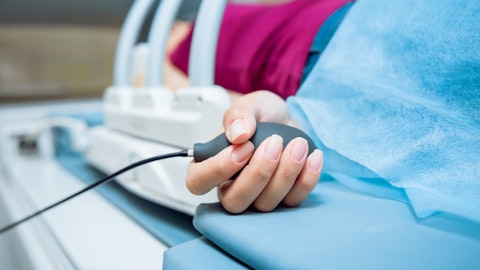Larry Solow: Got it. And just to clarify, on the Engineering segment; it sounds like there’s some growing pains there. So, growth taking a little bit of a step back and just shoring up manufacturing and execution. But you also mentioned, you still do expect a little bit of — I think that’s correct but you also mentioned a little bit of still margin expansion in ’24 in that segment. Did I hear that right?
Marco Dal Lago: Yes, this is what we expect. We expect to improve the overall situation in our projects and on top of it to push more on after sales activities. And yes, about the growth, you are right but we need also to underline the fact that we are growing significantly. In engineering, we had a compound annual growth rate of 26% if we compare to 2019. So in this project business, we believe is normal to have some fluctuation but the trajectory is still there.
Larry Solow: Got it. Okay. And just lastly, just on the in vitro diagnostics piece, is that — I know there’s a bunch of moving parts on the vials or the less vial demand. Has the — just specifically on the in vitro diagnostics, I think that also was a driver, a little bit of down demand in vials in ’23. Do you expect that to normalize? Or is that also lingering into ’24?
Franco Moro: Yes, the situation is not exactly the same in virus. We have already seen some positive signals in recovery in the last part of last year but we still expect to have a business that will not be at the normal situation in 2024 and we expect that the situation will normalize later. But this kind of expectation are completely embedded in our guidance upside.
Operator: The next question is from Dave Windley at Jefferies.
David Windley: I have a few. I want to start as a follow-up to Larry’s question on engineering, on the particularly, Marco, on the sales part. I believe I’m hearing management say that you’re kind of tamping down the sales activity in there in that business in favor of focusing on current projects and bringing them to fruition. Am I understanding that correctly that are you not adding to orders or adding to backlog and engineering right now?
Marco Dal Lago: No, basically, we are really focused to deliver to our customers in this period of time. So — please remember that the revenue recognition is based to a cost-to-cost approach. So we are mainly, mainly focused to complete our projects and we expect a near flat in terms of third parties revenue to — compared to prior year. The overall segment is growing, also leveraging the fact that we are growing our capacity for Fishers and for Latina. So this is our expectation for 2024.
Franco Moro: David, it doesn’t mean that we are not focused on the future growth of the engineering segment because we are putting more resources. We are optimizing our supply chain. We are — and also the industrial setup. So it’s not because we are stepping down from expectation for the future is just that we want to be very conscious about having new business according to the possibility to deliver.
David Windley: Understood. Second question, second topic is around margin. So I want to understand more specifically, particularly — I mean, overall but particularly in BDS, with the vials are a headwind. I understand that and understand high-value vials or ready-to-use vials are more “high value than ready-to-use syringes but you also called out in the deck ready to use Nexa syringes which I would think would be higher value, higher margins. So the question is why with high-value percentage in the highest you’ve ever recorded, did you actually see margin pressure in BDS given the mix?
Marco Dal Lago: Yes, David, you are right. As mentioned many times, the range of gross profit margin in value products is between 40% to 70%. So we have, how can I say, a quite a big range. The mix within the mix can impact. And this is one reason. The other one, as mentioned, is more in bulk and underutilization, a temporary underutilization of our lines. And obviously, the cost and efficiency that is temporary underutilization can bring to our P&L. So those are the 2 main reasons together to the already anticipated start-up cost and validation cost for the ramp-up in fishes and Latina have also in our model, just to complete the picture in the model, some currency headwind, we expect euro to get stronger with respect of the U.S. dollar.
And as you know very well, today, we have more manufacturing footprint in Europe and partially in Mexico compared with the U.S., where we are, on the other side, growing our sales with a growing sales in U.S. dollars. So this is another effect we have in the in our model to explain the slight decline we expect in BDS, partially offset obviously by the mix shift to a high value products.
Lisa Miles: And Dave, one other piece of color as it relates to Q4 of last year and the extraordinary margin performance out of BDS. I just want to point out that as it relates to those easy fill vials, that — that was for one specific customer that we deliver those for and it was highly accretive.
David Windley: Okay. Last question is around kind of committed orders and Marco, you also addressed this a little bit earlier on the low end of the range. But if I look at flattish committed orders year-over-year and because you’re not going to provide that number quarterly, it will be obviously harder to track — and I heard you say in the prepared remarks, you expect orders to pick up in the second half which implies to me that that pickup doesn’t really impact the second half revenue but rather probably helps 2025. I’d love for you to elaborate a little bit more on how a flat order book picture, a revenue contribution from Fishers kind of starting in earnest in early ’25 instead of mid-’24 and an overall order picture that doesn’t pick up until later in the year, gets you to 10% revenue growth.





